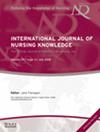Content validation of the defining characteristics of the nursing diagnosis “impaired swallowing” using the Delphi technique: A study with dysphagia nursing experts in Japan
Abstract
Purpose
Nurses’ clinical reasoning skills regarding impaired swallowing can help prevent patient complications and maintain quality of life. Clinical reasoning skills need content-validated defining characteristics (DCs). We aimed to validate the content of these DCs for nursing diagnosis “impaired swallowing.”
Methods
Content validation of the DCs was performed by 275 dysphagia nursing experts in Japan, using 3 rounds of the Delphi technique and Fehring's Diagnostic Content Validation (DCV) model. Three rounds of questionnaires on 84 DCs were completed via printed mail.
Findings
The valid response rates for each round were as follows: round 1, 90.2%; round 2, 77.8%; and round 3, 71.3%. Of the 84 DCs, 77 that met the consensus criteria were categorized as major (n = 18), minor (n = 45), and excluded (n = 14). There were four minor DCs other than the oral, pharyngeal, and esophageal phases. DCs listed from outside NANDA-I included 12 major, 16 minor, and 3 excluded characteristics. Of the NANDA-I DCs, 5 were no consensus and 11 were excluded. The total DCV score for the 63 major and minor DCs was 0.8.
Conclusions
Our results recommend the addition of 28 DCs and the exclusion of 11 for the NANDA-I nursing diagnosis “impaired swallowing” (00103). Major DCs were prominent indicators of impaired swallowing and signs of aspiration or pharyngeal residuals. Minor DCs included not only the three phases but also other signs necessary for a comprehensive understanding of impaired swallowing.
Implications for nursing practice
This validation study strengthens the clinical usefulness of the DCs for impaired swallowing, which can improve nurses’ clinical reasoning skills. Major and minor DCs can increase the awareness of impaired swallowing and enable accurate intervention, thereby preventing patient complications and maintaining quality of life.

 求助内容:
求助内容: 应助结果提醒方式:
应助结果提醒方式:


